Swedish BRT Guidelines
- Like
- Digg
- Del
- Tumblr
- VKontakte
- Buffer
- Love This
- Odnoklassniki
- Meneame
- Blogger
- Amazon
- Yahoo Mail
- Gmail
- AOL
- Newsvine
- HackerNews
- Evernote
- MySpace
- Mail.ru
- Viadeo
- Line
- Comments
- Yummly
- SMS
- Viber
- Telegram
- Subscribe
- Skype
- Facebook Messenger
- Kakao
- LiveJournal
- Yammer
- Edgar
- Fintel
- Mix
- Instapaper
- Copy Link
Posted: 21 July 2016 | Stenerik Ringqvist and Sven-Allan Bjerkemo | No comments yet
Consultants Stenerik Ringqvist and Sven-Allan Bjerkemo discuss the outcomes of a guideline project that will implement and adapt BRT solutions and strengthen the Swedish public transport sector.
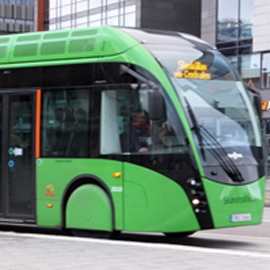

Guidelines for attractive public transport with a focus on BRT.
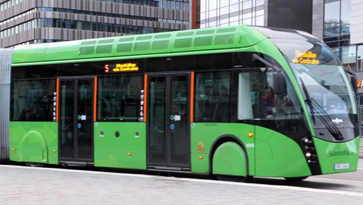

Modern BRT concepts are new promising challenges for an attractive public transport in Sweden. There are many BRT solutions internationally and a need to adapt them to Swedish conditions – to smaller and medium sized cities. Neither there was a common view on BRT in Sweden. To strengthen the Swedish Public Transport sector for implementing high quality bus services, a guideline project was initiated 2014 and published in 2015.
The guidelines meet the needs of an attractive and high capacity public transport in the range between ordinary bus services and metro/local rail. The guidelines aim to develop a high standard public transport that will meet the PTx2 challenges. Guidelines agreed by the sector will give broader understanding and knowledge of BRT for local implementation of Public Transport with fewer compromises. Most standard factors in the Guidelines will also help increase the quality of common city bus services.
BRT can be relevant in local contexts such as,
- The core network in the city complemented by feeder services and local bus routes, for example, in smaller and medium-sized towns and cities
- Complement to an overall system for interconnecting hubs and target points in large cities with fixed-rail solutions
- Central, main part of the network to ensure an attractive and reliable public transport where other parts can be given priority in mixed traffic
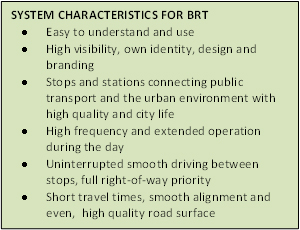

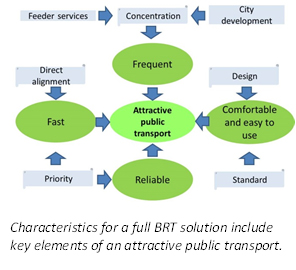

Part of the urban environment
Integration of the public transport infrastructure in the built-up area is necessary. Transit oriented developments require a holistic perspective including city structure planning, infrastructure and public transport operations.
The multidisciplinary approach in the planning stage is vital. The design of the city provides the conditions for the attractiveness and efficiency of public transport and influences the costs for public transport operations. The guidelines point out some key elements to achieve a successful implementation of BRT solutions.
The Swedish guidelines concern four areas:
- The design of the city
- Urban structure, planning and design
- Interaction with bus stops close to main activities
- Integrated routes for high accessibility and efficiency
- Public transport infrastructure
- Priority measures
- Design of stops and carriageway
- Identity
- Vehicles and support systems
- Vehicle requirements
- Information on stops and vehicles
- Identity
- Traffic operations
- Driver support systems
- Ticketing
- Frequency and operation duration of the day
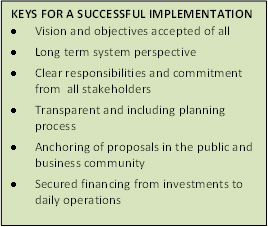

The standard requirements have two levels – green level required for high, recommended standard BRT. Yellow level is acceptable partially to meet the high-level standard of a BRT system. In total, 19 standard criteria are included in the guidelines, see examples below:


In Sweden, “Malmöexpressen” was the first BRT inspired bus route. It has operated in the city of Malmö since 2015. The rebuilt route has partly separated lanes in red asphalt and bi-articulated hybrid buses are used. Several cities in Sweden are now discussing BRT concepts. In the years to come, Sweden will have several high quality bus solutions inspired by the international BRT development.
A group of experts have developed the Swedish guidelines based on international examples. Representatives from PTA, PTO, National agencies, Cities and municipalities, bus Industry and consultants have discussed and anchored the guidelines in workshops. The Swedish Transport Administration and Swedish Energy Agency have granted the project.
Please download the English BRT brochure here . Download the full report, unfortunately in Swedish only, here.
There are also short Guidelines for light rail presented in June 2015 as a follow up.
The K2 Research Centre has recently initiated a high quality guideline project for structuring regional bus services. The K2 Research Centre in Lund, Sweden, is an independent institute for enforcing exchange of research, knowledge and experiences within the Public Transport sector. Please follow www.k2centrum.se.
|
Biographies
Stenerik is a senior consultant with 40 years’ experience in the field of Public Transport. He was CEO of a Swedish Public Transport Authority for 16 years. Since 1999 he has been working in the field of strategic planning and organisation as consultant and advisor to authorities and governments in the Nordic countries as well as advisor and project manager in several international projects for example in Chile, South Africa and India. He was appointed seconded expert at UITP in Brussels 2010 -2014 representing the Nordic countries. He was project manager for the BRT guidelines as well as the Light Rail guidelines
Sven-Allan is a highly experienced consultant in the field of Public Transport, Transportation, Urban and Regional Planning. He holds a master degree in Civil Engineering and complementary education in Environmental Care, Economic geography and a Nordic Post-Planning education. He also holds Pedagogic courses and runs a lot of education in local Technical University departments. He worked at the EU-COST project TU0630 Buses with High Level of Standard, BHLS, as a Swedish representative in Managing Committee and as a workgroup specialist. He was member of the expert group for the BRT guidelines. |
Related cities
Sweden





